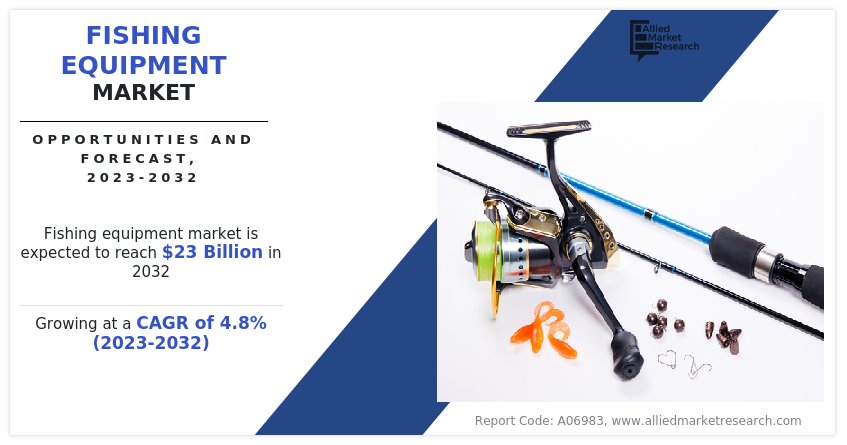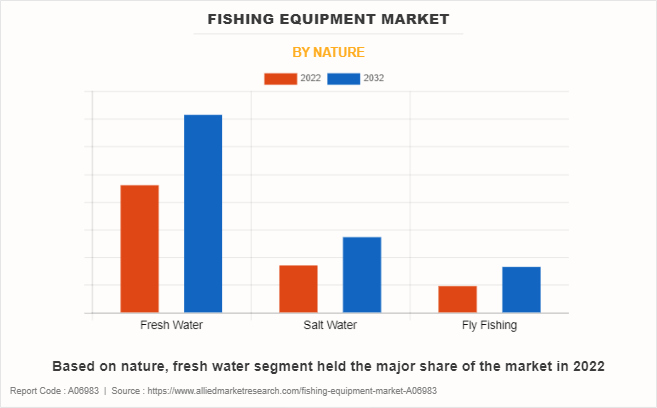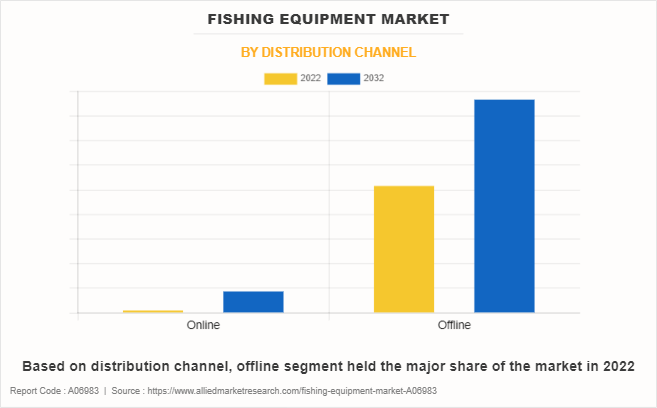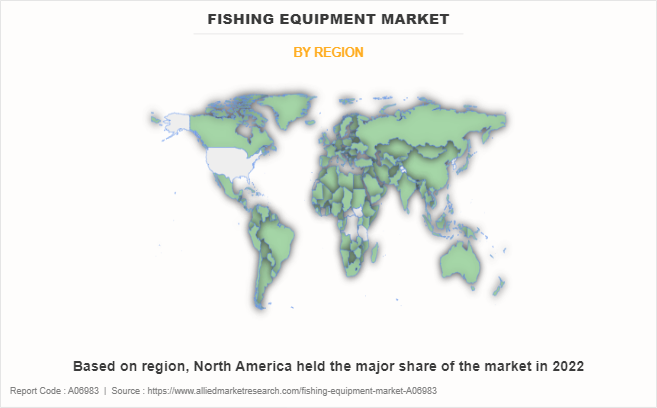Fishing Equipment Market Research, 2032
The global fishing equipment market size was valued at $14.5 billion in 2022 and is projected to reach $23 billion by 2032, growing at a CAGR of 4.8% from 2023 to 2032. Fishing equipment refers to the tools, gear, and accessories used by anglers to catch fish. This equipment can vary depending on the type of fishing, such as freshwater or saltwater, fly fishing, ice fishing, or deep-sea fishing. Fish equipment includes hooks, lines, sinkers & floats, rods, reels, nets & traps, spears & gaffs, and others.

Sports fishing is gaining ground and becoming prevalent in several regions around the world. Sports fishing term refers to fishing or shellfish collection, which is done primarily for pleasure. Moreover, sports fishing can take place in both salty and fresh water. Furthermore, nations such as the UK and the U.S. are making efforts to raise their fishing platform owing to which there is improved access to water bodies to fish in and make it a popular sport.
Various fishing associations such as the American Sportfishing Association are inspiring people to raise their participation in fishing by organizing several fishing programs and events. In addition, the most common type of fishing equipment used in sports is rod, line, reel, hooks, and a wide range of baits or lures such as artificial flies. Moreover, owing to the increase in popularity of fishing as a sport and as a recreational activity in countries such as the U.S., UK, China, and others has forced the government the develop fishing activities and equipment, which also boosts fishing equipment market growth.
Fishing techniques are methods for catching fish and include hand gathering, netting, trapping, angling, and spearfishing. Moreover, recreational, artisanal, and commercial fishers use different techniques and sometimes similar techniques. Recreational fishers fish for pleasure or sport and they mostly use angling methods for fishing in both salty and fresh water.
Furthermore, modern fishing techniques such as electric reels, modern rods, and nets have added accuracy to the fishing techniques. Thus, the increase in efficient fishing techniques further boosts fishing equipment market demand.
The rise of e-commerce has revolutionized the way fishing equipment is sold. Online retailers offer a wide range of products, competitive prices, and convenient shopping experiences. This has expanded the reach of the fishing equipment market and created new opportunities for both consumers and businesses. Online selling platforms have truly transformed the way fishing equipment is bought and sold. These digital marketplaces have turned geographical boundaries into mere dots on a map, transcending the limitations of physical stores. This means that anglers and fishing aficionados can now easily access an extensive range of fishing gear, from fishing rods to reels and all the accompanying accessories, with just a few clicks.
This unprecedented accessibility isn't just a boon for customers; it's also a game-changer for businesses. These platforms have unlocked a world of opportunities for fishing gear retailers to reach a broader customer base and expand their operations. As a result, both buyers and sellers are enjoying the benefits of this digital revolution in fishing equipment industry.
With the increase in disposable income, consumers have more spending capacity to invest in fishing equipment. High-quality fishing gear, including premium rods, reels, and electronics, is often a preference for anglers, and increased income allows for these purchases.
Moreover, the rising disposable income enables anglers to explore a wider range of fishing experiences. Consumers may pursue various types of fishing, such as freshwater, saltwater, fly fishing, and deep-sea fishing, each of which may require specific gear and equipment. This diversification of fishing interests and the ability to afford the necessary equipment is expected to propel the growth of the fishing equipment market.
The growing emphasis on sustainability and environmental responsibility presents an opportunity for manufacturers to develop and market eco-friendly fishing equipment. Products made from recycled materials, reduced waste packaging, and sustainable fishing practices align with the preferences of environmentally conscious consumers. Brands that prioritize sustainability can differentiate themselves in the market and attract a niche customer segment.
Modern fishing equipment and techniques are changing the ocean environment in various ways such as disturbing the sea floor, changing the food webs, and shifting many important ecosystem functions. Moreover, abandoned and lost fishing gear or equipment is deadly to marine life as it make up the major large plastic pollution in the oceans, rivers, or ponds. In addition, this lost or forgotten fishing gear is more destructive because it can ensnare lots of animals that are not being harvested or used anyway. Furthermore, using mechanical or technological innovations such as the use of drones for catching fish results in reducing the number of debris within oceans. Thus, adverse effects of modern fishing equipment affect the marine environment and hence hamper the growth of the market.
Segment review
According to the market analysis, the global fishing equipment market is segmented into type, nature, distribution channel, and region. Based on type, the fishing equipment market is divided into hooks, lines, sinkers & floats, rods, reels, nets & traps, spears & gaffs, and others. By nature, the market is divided into fresh water, salt water, and fly fishing. As per the distribution channel, the market is segmented into offline and online. Region-wise, the market is analyzed across North America (the U.S., Canada, and Mexico), Europe (Germany, France, Italy, Spain, UK, Russia, and the rest of Europe), Asia-Pacific (China, Japan, India, Australia & New Zealand, Korea, ASEAN, and rest of Asia-Pacific), and LAMEA (Brazil, South Africa, Turkey, Saudi Arabia, and rest of LAMEA).

Based on type, the hooks segment held the major share of the market in 2022. Modern fishhooks come in a variety of shapes, sizes, and materials. Hooks are either designed as single hooks, double hooks, or triple hooks. In addition, double hooks are made from a single piece of wire and may or may not have their shanks, which are brazed together for strength. Moreover, triple hooks are made by adding an eyeless hook to a double hook and brazing all three shanks together.

Based on nature, the freshwater segment held the major share of the market in 2022 and is expected to maintain its dominance during the forecast period. Fresh water is naturally occurring water except seawater and brackish water. Fresh water is generally characterized by having low concentrations of dissolved salts and other total dissolved solids. Fresh water includes water in ponds, lakes, rivers, streams, reservoirs, and others. Various types of fishing equipment such as rods, reels, hooks, rigs tackle, and others, are used for catching fish in fresh water.

Based on the distribution channel, the offline segment held the major fishing equipment market share in 2022 and is expected to maintain its dominance during the forecast period. Offline includes specialty stores and brand outlets. Brand outlets are company-owned stores through which the manufacturers directly sell their goods to the customers. Market players are establishing new brand outlets. The affluent customers are the ones who often buy fishing equipment through brand outlets as they have higher disposable income and can afford premium products. The brand outlets segment of the market is driven by an increase in the population of affluent customers in mature and emerging markets across various regions to extend their reach and increase their customer base.

Region-wise, North America was the largest market in 2022 and held the major share of the market in 2021. In terms of macroeconomic factors, the U.S. is the largest economy in the world in terms of GDP with a greater degree of flexibility compared to the business in Western Europe. The rise in population and improved lifestyle are the key factors that drive the growth of the market. An increase in purchasing power in this region majorly boosts the sale of fishing equipment products in this region.
The players in the market have adopted acquisition, business expansion, partnership, collaboration, and product launch as their key development strategies to increase profitability and improve their position in the fishing equipment market.
Some of the key players profiled in the fishing equipment market analysis include Rome Specialty Company, Inc., GLOBERIDE, Inc., Pure Fishing, Inc., Sea Master Enterprise Co., Ltd., Maver UK Ltd., JARVIS WALKER Pty Ltd, PRADCO OUTDOOR BRANDS, JOHNSON OUTDOORS INC., TICA FISHING TACKLE, and Bright Tribe, Inc.
Key Benefits For Stakeholders
- This report provides a quantitative analysis of the fishing equipment market statistics, current trends, estimations, and dynamics of the fishing equipment market analysis from 2022 to 2032 to identify the prevailing fishing equipment market opportunities.
- The market research is offered along with information related to key drivers, restraints, and opportunities.
- Porter's five forces analysis highlights the potency of buyers and suppliers to enable stakeholders make profit-oriented business decisions and strengthen their supplier-buyer network.
- In-depth analysis of the fishing equipment market segmentation assists to determine the prevailing market opportunities.
- Major countries in each region are mapped according to their revenue contribution to the global market.
- Market player positioning facilitates benchmarking and provides a clear understanding of the present position of the market players.
- The report includes the analysis of the regional as well as global fishing equipment market trends, key players, market segments, application areas, and market growth strategies.
Fishing Equipment Market Report Highlights
| Aspects | Details |
| Market Size By 2032 | USD 23 billion |
| Growth Rate | CAGR of 4.8% |
| Forecast period | 2022 - 2032 |
| Report Pages | 310 |
| By Type |
|
| By Nature |
|
| By Distribution Channel |
|
| By Region |
|
| Key Market Players | Johnson Outdoors Inc., Maver UK Ltd., GLOBERIDE, Inc., JARVIS WALKER Pty Ltd., Sea Master Enterprise Co., Ltd., Gamakatsu Co., Ltd., PRADCO Outdoor Brands, Tica Fishing Tackle, Rome Specialty Company, Inc, Pure Fishing, Inc. |
Analyst Review
According to the insights of CXOs of leading companies, the fishing equipment market holds a substantial scope for growth; however, its contribution to the global market is expected to increase significantly within the next six years. Innovation is the key to the success of the fishing equipment market.
Innovation is the key to growth of the global fishing equipment market, in terms of value sales. The launch of new fishing equipment with enhanced technologies by leading market players has raised interest in fishing among the public. These fish equipment manufacturers have taken care of problems that were faced during fishing and have come up with necessary solutions. Aquadrone is the leading producer in the fish equipment market, which offers customized drones specifically to catch fish. Moreover, the drones are designed to find fish using sonar, take images using a camera installed on them, install a bait & lure, and visit the same spot to catch fish. This device is 100% waterproof and can be used in both fresh and salt water. Furthermore, Aquadrone has become more popular among the younger generation and ones with less patience to wait to catch fish. Thus, rapid advancements in technology in fishing equipment boost the growth of the fishing equipment market.
The global fishing equipment market size was valued at $14,474.2 million in 2022 and is projected to reach $23,010.4 million by 2032, registering a CAGR of 4.8% from 2023 to 2032.
According to the market analysis, the global fishing equipment market is segmented into type, nature, distribution channel, and region. Based on type, the market is divided into hooks, lines, sinkers & floats, rods, reels, nets & traps, spear & gaffs, and others. By nature, the market is divided into fresh water, salt water, and fly fishing. As per distribution channel, the market is segmented into offline and online. Region-wise, the market is analyzed across North America (the U.S., Canada, and Mexico), Europe (Germany, France, Italy, Spain, UK, Russia, and rest of Europe), Asia-Pacific (China, Japan, India, Australia & New Zealand, Korea, ASEAN, and rest of Asia-Pacific), and LAMEA (Brazil, South Africa, Turkey, Saudi Arabia, and rest of LAMEA).
North America is the largest regional market for fishing equipment.
The major players analyzed for the fishing equipment market are Rome Specialty Company, Inc., GLOBERIDE, Inc., Pure Fishing, Inc., Sea Master Enterprise Co., Ltd., Maver UK Ltd., JARVIS WALKER Pty Ltd, PRADCO OUTDOOR BRANDS, JOHNSON OUTDOORS INC., TICA FISHING TACKLE, and Bright Tribe, Inc.
The global fishing equipment market report is available on request on the website of Allied Market Research.
The forecast period considered in the global fishing equipment market report is from 2023 to 2032. The report analyzes the market sizes from 2022 to 2032 along with the upcoming market trends and opportunities. The report also covers the key strategies adopted by the key players operating in the market.
Loading Table Of Content...
Loading Research Methodology...



